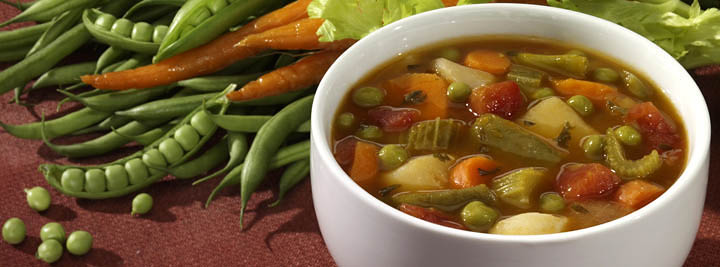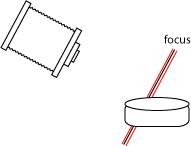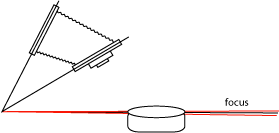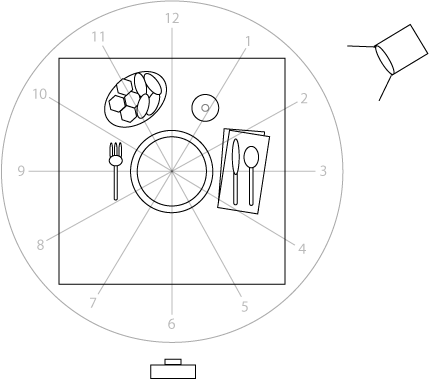|
Photographing and the photographic lighting of food, and especially soup, is a lot harder than it looks. Unlike the typical food shoot, there are a few things that limit what you can do to make soup look good. Explaining how to overcome these soup-specific photographic lighting obstacles is the purpose for this article. After reading this, you will understand the many food photography tips tricks and techniques need to successfully photograph soup.
|
||||||
Make sure that the table / bowl is level when photographing soupSounds like a pretty petty thing to start out with, but I can’t tell you how many times that we’ve had everything all set and ready to go, only to find out that the soup level was tilting off to one side. So before you start to light, make sure that the bowl is level. And that doesn’t necessarily mean that one the table is level, that the bowl will be level. Many shots will have the bowl sitting on top of a napkin, table runner or something else that may influence the level of the bowl. It may be necessary to shim up the bowl after the composition is set up. What should you use to shim up the bowl? Anything will do. I like to use these little plastic shims that can be purchased at a restaurant supply store. I believe they’re designed to keep restaurant tables from wobbling, but they work really well to level soup bowls. If the leveling process requires you to shim from the front, and you’re afraid that the shims will be seen in the photo, you will probably need to shim the entire table, in order to level the bowl. |
||||||
Higher than normal camera angle for soup photographyWhile I usually prefer to get really low when photographing most foods, soup requires you to go a little higher then normal. If you go too low when shooting soup, you end up with more bowl than soup. And unless your client is a china manufacturer, you need to go a bit higher than normal. Clients, for some odd reason, like to make their product the star of the shot. For the novice, it may seem logical that the higher you go, the more soup you’re going to see. While that may seem rational at first thought, in reality, it’s really not a good idea. Look down, from too high an angle, tends take away all dimension from the photo. Creating and emphasizing dimension, not minimizing it, is what the photographer needs to do to make his two-dimensional photo as three dimensional as possible. It’s hard to see that chunk of vegetable just peeking out above the surface of the soup, and the higher you go, the tougher it will be to see. There’s a general rule of thumb in food photography. Lower is better. Yes, you can go too low. But, on the other hand, you’ll be surprised at the improvement in your food photography if you just push that envelope a little and go a little lower then you think you should. |
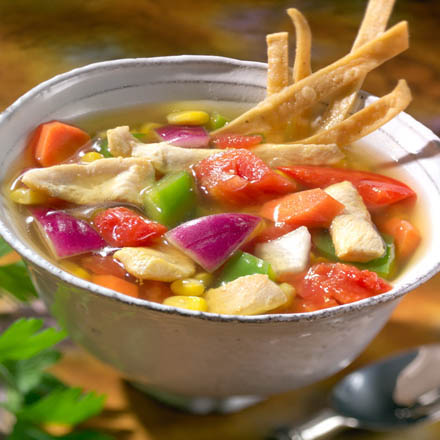 |
|||||
|
|
||||||
Focus tactics for soup photographyPersonally, I’m a big fan of “minimum focus”, but often times the client dictates whether they want the entire bowl of soup in focus or if you are allowed to have a little artistic license. If you choose to use minimum focus, my opinion is that focusing ¼ to 1/3 into the bowl gives you the most appealing effects. I rarely see food shot where the focus has something in the back of the frame in focus and the front of the frame out of focus. But keep in mind that this is a very subject thing and for all I know, it’s tomorrow’s “new” / “hot’ trend. (Remember, you heard it here first!) One focus tactic that I really like is to manipulate the focus so that the entire surface of the bowl is in focus, but the aperture is so wide open and the depth of field is so thin that the bottom of the bowl, and everything around it is out of focus. This is a really cool effect, but unfortunately for most of you, you need a view camera to accomplish this effect. I’ve created an illustration to show you what I mean. |
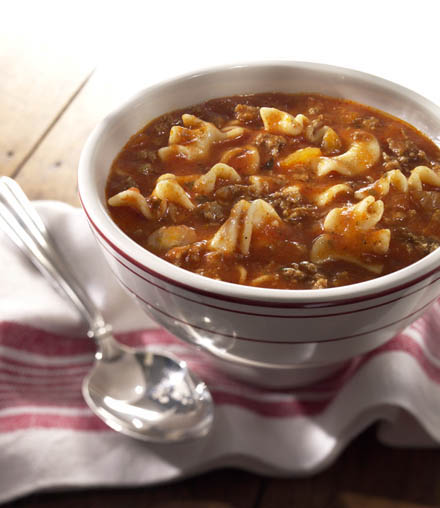 |
|||||
|
||||||
Need for higher than normal main light for photographing soupWhile I like to “scrape” light across my food subjects, the lip of the bowl prevents me from keeping the main light as low as I’d like it. So, it’s a compromise, like the rest of life. I like to keep the light as low as I can while keeping the cast shadow from the lip of the bowl as short as I can get it. That is a very subjective call and only you will be able to make it depending on everything that going on. There’s no rule of thumb here. Lighting for soup-chunk shape in soup photographyLike I said before, I like to “scrape” light across my food subjects in order to emphasize the texture. And with soup photography, there’s usually not a whole lot of texture to begin with, so getting as much scrape effect as possible is a major concern. One way to tweak the lighting for a little more texture is to keep the fill light as low as possible, but then again, you have that darn soup bowl lip and shadow to contend with. Soup is really a pain in the butt to shoot. |
|
|||||
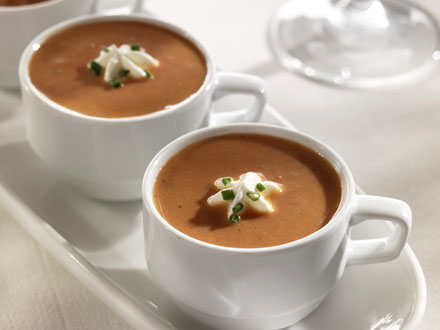
Light direction is usually determined my things other than the soup itself. Sometimes the props determine the main light's placement. |
Like most other food photographs, I usually choose to come in from either 10 or 2 o’clock with my main light. I’ve found from experience, that this light direction tends to give me the most shape from my subject without getting much glare from the main light. I choose which of these two possible directions to light from usually base on the other elements in the shot. Since soup is a relatively “symmetrical” subject, it usually doesn’t matter from which direction the light will come. The only exception that I can think of for lighting from one direction over another might be in the case where there is a spoon or something else in the soup or on the bowl. In this case, I try to avoid any objectionable cast shadows across the surface of the soup. The same goes with any tall objects outside the soup, like a glass or some other prop. There have been times when a cast shadow across the main food object has been interesting, but most times it’s ends up looking like a mistake. But that doesn’t mean you shouldn’t try to push that envelope every once in a while. | |||||
|
|
||||||
Controlling the surface reflections on soupAnother thing that makes shooting soup a pain in the butt (challenging) to shoot, is the surface is very reflective. You need to be very careful in where you put your lights so as not to get any unwanted reflections in the surface of the soup. Notice that I said “unwanted” reflections. I suggest that you do get some reflections in the soup surface, but you have to be very careful where they are and also the quality of those reflections. If you eliminate all reflections from the soup surface, like most novice photographers strive to do, you end up with really boring soup. And nobody likes really boring soup. Most soup, (how’s that for a generality…) lies relatively flat in the bowl. From your camera angle, there is an area of you background that will reflect into the soups surface. If you keep any lights out of that area, you will be able to minimize any reflections that will appear in the surface of the soup. If you soup has pieces that stick out of the surface, you will probably encounter some highlights, but you’ll need some reflections to make things look a little mire interesting. |
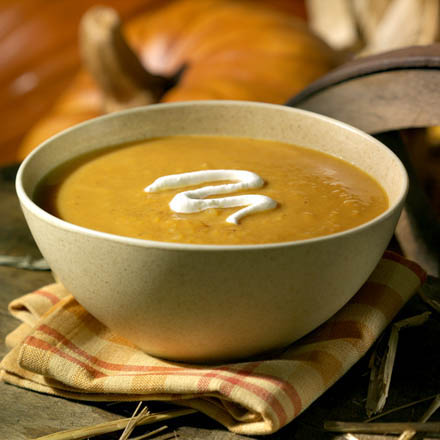
Soup that doesn't have much in the way of particulate protrusion, is tough to make look interesting. |
|||||
|
|
Soup is usually made up of a pool of liquid, with chunks of stuff sticking up through he surface. When these chunks stick up through the surface, they cause a meniscus to form. A meniscus is where the liquid bends up (curves) to seep up the chunk. This meniscus is where you can get some really interesting (or lousy) highlights. You can usually keep unwanted reflections off of the surface of the soup, but the meniscus is where you have the opportunity to create attractive highlights and the danger of unattractive and unwanted highlights. Actually, the meniscus will form completely around any chunk that protrudes above the surface of the soup, but for the sake of our discussion, I will be calling the meniscus on the side of the chunk that faces the camera, the “front meniscus” and the meniscus that is on the side of the chunk that faces away from the camera, the “rear meniscus”. |
|||||
|
|
||||||
Lighting for the meniscus in soup photographyTo me, this is the interesting part of this article and the thing I struggle with most often. I’ve been shooting soup for various clients over the years and until just recently, I’ve never been truly happy with the results. I’ve finally come up with a lighting setup that I’m happy with. Of course, it doesn’t work in every situation or on every type of soup, but generally, it works pretty well. Recently, I’ve added two new lights to my soup lighting set-up, an overhead box and a rear box. |
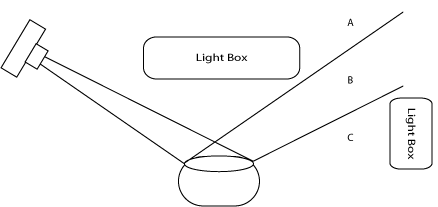
If you want to avoid glair on the top of your soup, you can't have any lights in the are marked "B". The C area is where the rear meniscus light should be placed and the A area is where the front meniscus light should be placed |
|||||
|
The overhead box is another layer of fill light (more on that later) and it also gives you a really nice front meniscus highlight. You need to keep this overhead box on a relatively low power so as to keep the fill effect to a minimum and also to keep the meniscus highlight appealingly transparent. The front meniscus highlight really adds a degree of interest to the whole shot and is what’s missing in moist food soup shots to make them look good. This is the biggest key to good soup photography, in my humble opinion. Good frontal chunk meniscus lighting is very important, (say that three times really fast :+) but there is something else that I’ve discovered recently that is really kinda cool too. It’s the rear meniscus light. The last few soup projects I’ve shot have included a large strip box directly behind the soup and low enough so that it avoids the main glare angle of the soup surface. (See illustration) This light gives my photos that little bit extra dimension that makes the soup surface a little more interesting than normal. This light too, needs to be kept at a relatively low level compared to the main light. You just want a little “something” going on and not a big-ass “ching”. As you become better as a photographer, it’s all about the subtleties. |
||||||
|
|
||||||
How to photograph flat soupI call soup that doesn’t have any particulate matter protruding from the surface, flat soup. In this case, there is nothing to “scrape “ light across, to give you interesting texture, and without texture, the soup can tent to look a little boring. In cases like this, I like to add a little glare into the surface of the soup. Yes, the same glare that I try to avoid on any other soup shot. One technique that I use is to put a large piece of smooth foam core behind the soup and shoot a soft spot light (grid spot) into it. This allows me to graduate the glare and put it where I want it. I try to avoid putting too much glare across the surface of the soup, because this tends to obscure the elements beneath the surface (if there are any) and it also tends to fog over any color that the soup or broth my have. Usually, I try to just put a little glare across one corner of the soup, covering maybe 10-20 % of the surface area. I don;t think it's a perfect solution, it's just that I haven;t found a way yet to make this kind of soup more interesting. If you have a better idea, I'm all ears... |
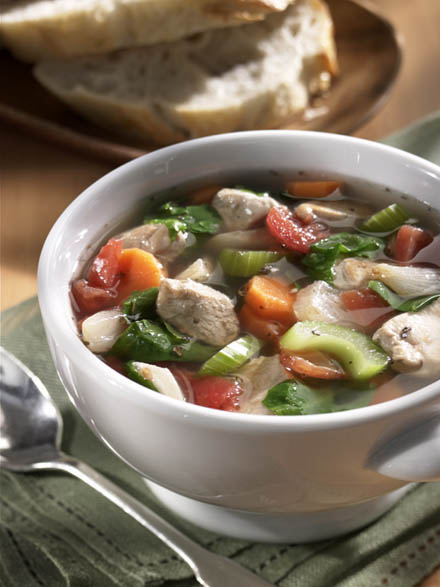 |
|||||
|
|
||||||
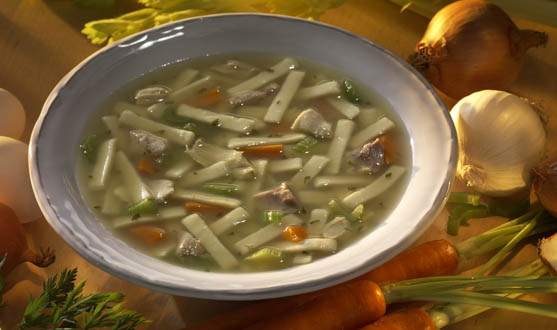 |
Lighting in the inside of the soup bowlBecause I usually use a small light source that casts a sharp shadow, I can use mirrors to redirect the light back into areas where I want the light to go. Often times, I will use a mirror or mirrors to lighten up the inside of the soup bowl. By using a mirror, I can keep the light on the soup and off the background elements. That comes in really hand when you’re trying to lighten up the soup and still keep your current lighting effect and light ration on the rest of the composition. |
|||||
|
The only problem with using mirrors is that you usually end up giving you very crisp (small) highlights. And again, you’ll have to weigh what you want, against what you get. Photographic lighting is truly a compromise. Like the song says, “you can’t always get what you want... you know the rest.” Another thing you need to remember when kicking light into the surface of the soup. As you add more light, you are negating the effect of your main light by filling in the shadows of the chunks and diminishing the three dimensional effect caused by scrapping the light across the surface of the soup. You are adding a fill light and the more fill you add, the “flatter” your lighting will become, even if it’s in a selected area. Only experience will let you learn what’s best. You will need to develop an eye from what’s best. Up until recently, I’ve usually chosen to use mirrors to lighten up the lip of the bowl and fill to “chunks”. I’ve always used my “true fill” technique to add fill to the whole shot, but recently I’ll been adding an “overhead” medium box to add a little more fill where I want it. What I find interesting about this new technique of mine, is that it has the added effect of actually adding another layer of shape to the photo. Frontal fill, that I call true fill, actually tends to lessen the shape caused by the main light, but by adding an overhead light too, it sort of wraps the main light around background elements a little. You can most often see this effect of cylindrical objects lying on their sides. (Corn, beans, napkins rolled up) This effect is relatively subtle, but to a professional that can see the difference, it makes a huge difference. The key is to have the overhead box a little farther back than directly overhead. Another benefit of using a box instead of a mirror, is that the highlights created by a box on the front meniscus are much softer that those of a mirror. And sometimes, softer is more attractive. |
||||||
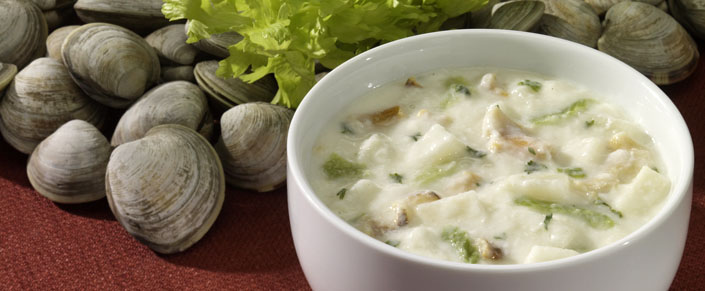 |
||||||
Lighting the outside of the soup bowlRemember, soup photography is only part of the battle. The soup is usually in some sort of environment, and you’ll need to make that look pretty too. I like to kick back the light from the main light into the outside of the bowl to give it some shape. The trick here is to keep the reflector (usually mirror) so low that it doesn’t kick any light “into” the bowl, just onto the outside of the bowl. If the mirror is too high and light is reflected into the bowl, you’ll end up with a double shadow on the rear lip of the bowl. Not good. And here, you thought that you just stuck a light anywhere beside the camera and you were fine… :+) |
||||||
|
Didn't find what you were looking for?
Join our mailing list or contact Michael Ray - Go to Michael Ray's food photography blog |
||||||

